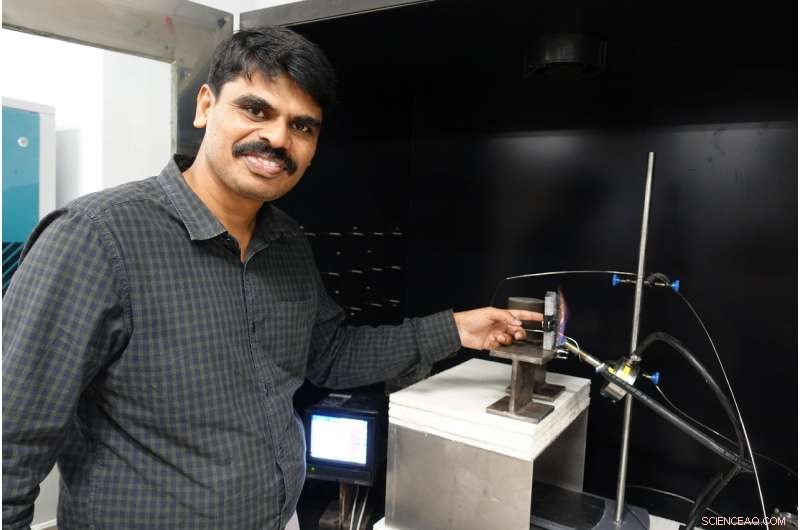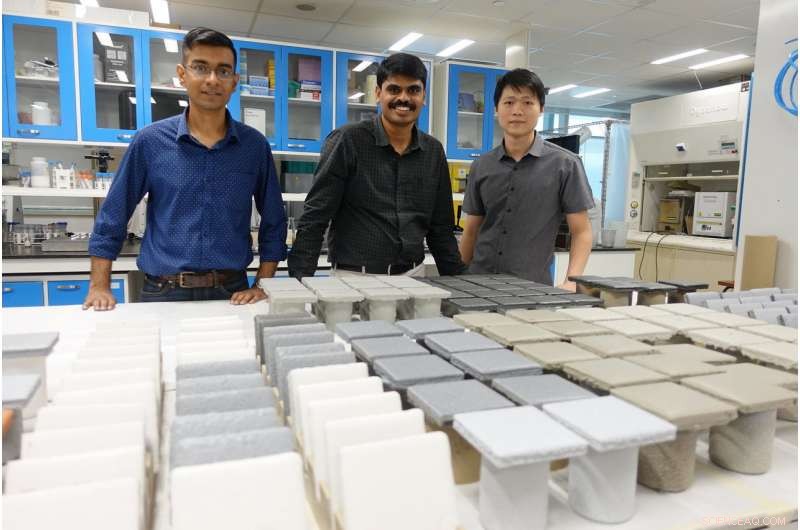
El profesor asistente de NTU Aravind Dasari poniendo su dedo en un pedazo de plástico que está lo suficientemente frío como para tocarlo, que se colocó detrás de una placa de acero recubierta con FiroShield y se expuso a una llama de más de 900 grados Celsius. Crédito:Universidad Tecnológica de Nanyang
Unas pocas capas adicionales de "pintura" podrían ser todo lo que el acero de un edificio necesita para evitar que se doble y falle en un incendio.
Científicos de la Universidad Tecnológica de Nanyang, Singapur (NTU Singapur) y el desarrollador industrial de Singapur JTC han desarrollado un revestimiento 3 en 1 asequible que ofrece una protección mejorada contra incendios y corrosión.
Las estructuras de acero existentes en los edificios generalmente están recubiertas con una capa retardante de fuego para proteger el metal desnudo de daños por fuego y cumplir con el estándar de protección contra incendios de dos horas, cuyo objetivo es dar a los ocupantes tiempo suficiente para evacuar el edificio. Los recubrimientos intumescentes convencionales de hoy son gruesos, más caro y laborioso de aplicar.
A diferencia de, Este revestimiento hecho en Singapur se puede aplicar al acero desnudo sin necesidad de pulirlo con chorro de arena para preparar la superficie. reduciendo el tiempo de recubrimiento a la mitad, y protegerá el material contra el fuego durante dos horas sin caerse.
Nombrado FiroShield, el nuevo recubrimiento es más económico y menos laborioso de aplicar, y puede funcionar estéticamente como pintura normal.
FiroShield también se ha probado en otros materiales de construcción, como hormigón armado y madera laminada, y tiene el mismo rendimiento excelente.
Al frente del equipo de investigación está el profesor asistente Aravind Dasari de la Escuela de Ciencia e Ingeniería de Materiales y el profesor Tan Kang Hai de la Escuela de Ingeniería Civil y Ambiental.
Los líderes del equipo señalaron el conocimiento que han obtenido a lo largo de los años de investigación sobre los diferentes aspectos de los polímeros y la combustión, combinado con experiencia en ingeniería civil y estructural, ayudó a simplificar su enfoque.
La fuerza de su recubrimiento proviene de una mezcla equilibrada de aditivos, que funcionan bien juntos para producir reacciones químicas simultáneas cuando se enfrentan a temperaturas extremadamente altas. Sabían que habían encontrado la fórmula correcta cuando pudieron recubrir muestras de acero de manera uniforme con una pistola rociadora.
"En un incendio, nuestro revestimiento forma una capa carbonizada compacta que actúa como barrera protectora contra el calor, "añadió el profesor Dasari, quien también es Investigador Principal en el Centro de Innovación de Infraestructura Industrial NTU-JTC (Centro I3).
"Si bien los revestimientos de fuego típicos también formarán una capa carbonizada, esos son gruesos y espumosos, que puede caerse fácilmente y dejar el acero expuesto al fuego. Lo que buscamos era una capa innovadora que funciona de manera diferente a los recubrimientos intumescentes convencionales y puede adherirse a la superficie de acero durante el mayor tiempo posible a altas temperaturas. y, sin embargo, tiene durabilidad y resistencia a la intemperie en condiciones normales sin necesidad de una capa superior de pintura ".
Sr. Koh Chwee, Director, División de Servicios Técnicos de JTC y Co-Director del Centro I3, dijo que a través de la colaboración con instituciones académicas como NTU, JTC tiene como objetivo desarrollar soluciones nuevas e innovadoras para mejorar la seguridad y la productividad de la construcción para sus proyectos de infraestructura industrial.
"La facilidad de aplicación de este nuevo revestimiento resistente al fuego y a la corrosión en estructuras de acero ayudará a reducir el trabajo intensivo, mejorando así la productividad y permitiendo un recubrimiento más rápido de componentes de acero prefabricados. Más importante, La capacidad del nuevo revestimiento para mantener una adherencia superior a altas temperaturas conduce a una mayor seguridad del edificio para los ocupantes. Confiamos en que el nuevo recubrimiento podrá reducir tanto el material de pintura como los costos de mano de obra, and become a new alternative to other fire protection products, " said Mr Koh.
Combination of materials used for coating
The base material of the new coating is made of synthetic resins, which are polymers commonly used to make paints. To give it fire and corrosion-resistant properties, Prof Dasari's team added a combination of common chemicals, including one that is endothermic – absorbing heat to start a chemical reaction that causes the coating to adhere firmly to the steel.
The team went further to develop a coating that is able to have assorted colours; pigments can be added to the mixture so it achieves the aesthetic function of normal paint. Paint manufacturers looking to add the benefits of FiroShield to their products should find that commercialisation is straightforward, as the innovation relies simply on the addition of key chemicals into their paint manufacturing process.

(From left) NTU research fellow Dr Indraneel S Zope; NTU Assistant Professor Aravind Dasari; and NTU PhD student Mr Ng Yan Hao; standing behind the rows of FiroShield-coated steel plates used in their research and development.
To achieve a two-hour fire rating, FiroShield requires just five layers of coating, compared to conventional coatings, which requires up to 15 layers or more. It is thus two times faster to apply and is cheaper by about 50 percent due to its lower materials cost and manpower requirements.
In addition to its fire-resistant properties and easy application, FiroShield can also protect the steel surface from corrosion, which no other fire coatings in the market can do at the moment. FiroShield is expected to last longer when exposed to weathering elements such as moisture and UV rays. Its performance barely dipped by two percent, as compared to the drop of up to 75 percent for conventional coatings when subjected to weathering tests in the lab. This will reduce the maintenance cost and frequency of inspections over the lifespan of a building.
For the next phase of development, FiroShield will be sent to the UK for an industry certification, which includes a load-bearing fire test that no facilities in Singapore can do currently.
Its proprietary formulation has been filed with NTU's innovation and enterprise arm, NTUitive, and upon the completion of the certification, NTUitive will work with JTC to explore commercialisation options.
After the certification, which is expected to be completed by April 2018, the new coating will be applied on steel structures within the upcoming JTC Logistics Hub. The joint research team will also work with the relevant agencies to roll out this technology on a larger scale.
Building on this technology, Asst Prof Dasari will also work with JTC at the I3 Centre to develop another type of innovative coating for the construction and building industry, which addresses more properties beyond fire and corrosion resistance.